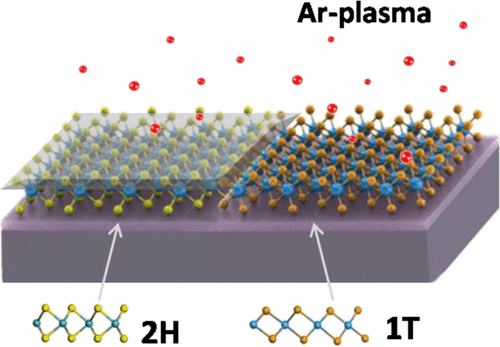当前位置:
X-MOL 学术
›
J. Am. Chem. Soc.
›
论文详情
Our official English website, www.x-mol.net, welcomes your
feedback! (Note: you will need to create a separate account there.)
Argon Plasma Induced Phase Transition in Monolayer MoS2
Journal of the American Chemical Society ( IF 14.4 ) Pub Date : 2017-07-24 00:00:00 , DOI: 10.1021/jacs.7b05765 Jianqi Zhu 1, 2 , Zhichang Wang 3 , Hua Yu 1, 2 , Na Li 1, 2 , Jing Zhang 4 , JianLing Meng 5 , Mengzhou Liao 1, 2 , Jing Zhao 6 , Xiaobo Lu 1, 2 , Luojun Du 1 , Rong Yang 1, 2 , Dongxia Shi 1, 2 , Ying Jiang 3, 7 , Guangyu Zhang 1, 2, 7, 8
Journal of the American Chemical Society ( IF 14.4 ) Pub Date : 2017-07-24 00:00:00 , DOI: 10.1021/jacs.7b05765 Jianqi Zhu 1, 2 , Zhichang Wang 3 , Hua Yu 1, 2 , Na Li 1, 2 , Jing Zhang 4 , JianLing Meng 5 , Mengzhou Liao 1, 2 , Jing Zhao 6 , Xiaobo Lu 1, 2 , Luojun Du 1 , Rong Yang 1, 2 , Dongxia Shi 1, 2 , Ying Jiang 3, 7 , Guangyu Zhang 1, 2, 7, 8
Affiliation

|
In this work, we report a facile, clean, controllable and scalable phase engineering technique for monolayer MoS2. We found that weak Ar-plasma bombardment can locally induce 2H→1T phase transition in monolayer MoS2 to form mosaic structures. These 2H→1T phase transitions are stabilized by point defects (single S-vacancies) and the sizes of induced 1T domains are typically a few nanometers, as revealed by scanning tunneling microscopy measurements. On the basis of a selected-area phase patterning process, we fabricated MoS2 FETs inducing 1T phase transition within the metal contact areas, which exhibit substantially improved device performances. Our results open up a new route for phase engineering in monolayer MoS2 and other transition metal dichalcogenide (TMD) materials.
中文翻译:

氩等离子体诱导单层MoS 2中的相变
在这项工作中,我们报告了一种适用于单层MoS 2的便捷,清洁,可控制和可扩展的阶段工程技术。我们发现弱的Ar-等离子体轰击可以在单层MoS 2中局部诱导2H→1T相变以形成镶嵌结构。这些2H→1T相变通过点缺陷(单个S空位)得以稳定,并且诱导1T域的大小通常为几纳米,如通过扫描隧道显微镜测量所揭示的。基于选定区域的相位图案化工艺,我们制造了在金属接触区域内引起1T相变的MoS 2 FET,从而显着提高了器件性能。我们的结果为单层MoS 2中的相工程开辟了一条新途径 以及其他过渡金属二硫化氢(TMD)材料。
更新日期:2017-07-25
中文翻译:

氩等离子体诱导单层MoS 2中的相变
在这项工作中,我们报告了一种适用于单层MoS 2的便捷,清洁,可控制和可扩展的阶段工程技术。我们发现弱的Ar-等离子体轰击可以在单层MoS 2中局部诱导2H→1T相变以形成镶嵌结构。这些2H→1T相变通过点缺陷(单个S空位)得以稳定,并且诱导1T域的大小通常为几纳米,如通过扫描隧道显微镜测量所揭示的。基于选定区域的相位图案化工艺,我们制造了在金属接触区域内引起1T相变的MoS 2 FET,从而显着提高了器件性能。我们的结果为单层MoS 2中的相工程开辟了一条新途径 以及其他过渡金属二硫化氢(TMD)材料。











































 京公网安备 11010802027423号
京公网安备 11010802027423号